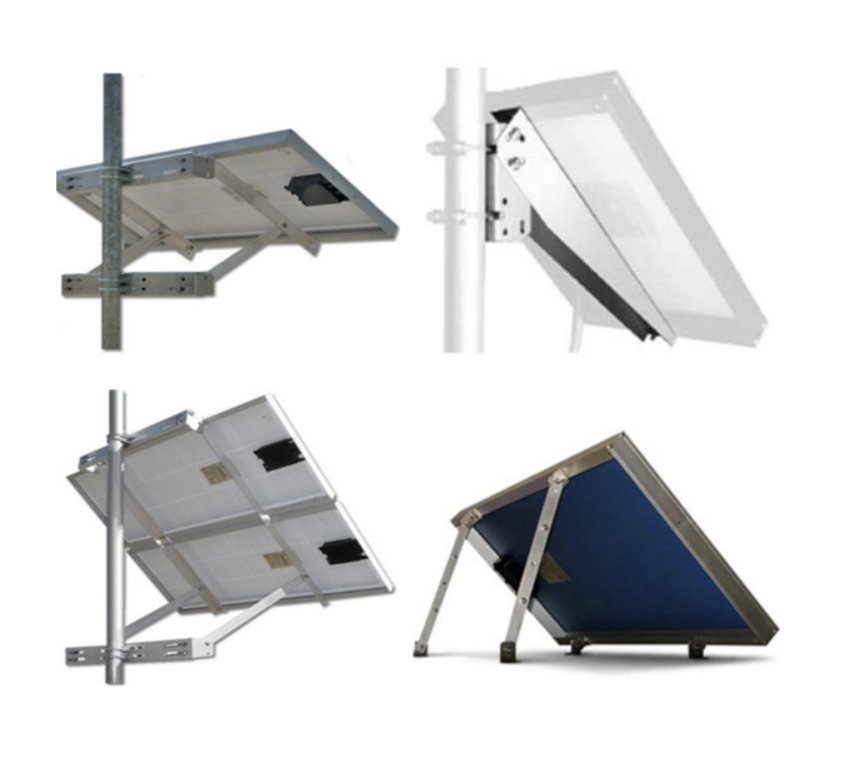Solar Panel Mounts

Solar panel mounts are essential components of any solar system, providing the structural support needed to securely attach solar panels to a variety of surfaces such as ground areas, flat roofs, or pitched roofs. These mounting systems are crafted to get the absolute best angle and position of the solar panels so that they are exposed to the maximum amount of sunlight. This, of course, exposes the whole solar system to a greater amount of energy, optimizing its efficiency and energy output. There are several types of solar panel mounts available, including fixed mounts, adjustable mounts, and tracking mounts, each built to accommodate specific site conditions and solar installation goals.
Ground mounts and pole mounts are popular choices for residential, agricultural, and commercial applications in which roof space is limited or orientation is less favorable. Solar panel systems that are installed on the ground can be put in places that make them easy to get to for maintenance and cleaning. Ground-mounted systems can be installed with concrete footings or driven poles. If poles are used, they can be spaced to create a kind of solar field that may be part of a small-scale or utility-scale solar installation. Some ground-mounted systems have the ability to tilt them at various angles, making them capable of following the sun as it moves across the sky from east to west.
More Information about Solar Panel Mounts
Solar panel systems mounted on roofs save ground space and integrate seamlessly into existing structures. They often employ ballasted or rail-based systems that eliminate the need to drill holes when installing on flat roofs, while on pitched roofs, they require more permanent attachments that align with the angle of the roof. The process of installation is critical; it influences the safety, stability, and longevity of solar systems. Whether they're installed on flat or sloped surfaces, the mounts must be selected for the particular application and installed correctly to withstand wind, snow, and other environmental factors. This ensures they deliver consistent, reliable performance over time.
FAQs
What projects in the solar industry would benefit most from aluminum, racking solar panel mounts?
Projects in the solar industry that would benefit most from aluminum racking solar panel mounts include commercial rooftop installations, utility-scale ground-mounted arrays, and residential solar systems requiring lightweight, corrosion-resistant, and durable mounting solutions.
What kind of equipment can installers use to determine the weight of a solar panel?
Installers can use digital platform scales or hanging crane scales to accurately determine the weight of a solar panel before or during installation.
Sizing a Solar System Tips and Tricks
Tips that can help save time and money when installing a solar powered electrical system
Always start with a site survey
This is one of the most commonly overlooked steps when planning a solar powered setup. Too often, solar systems are installed only to find out that the sun's light is limited in the location the panels were installed or the angle in which they were installed will not generate enough power for the hardware needs. Sometimes there simply isn’t enough room anywhere on site to install this type of system. Doing a proper solar site survey can assist in preventing some of these common challenges.
Take inventory of all of the electrical components and hardware for the system
By identifying what the maximum power requirements are for each component, the total power requirements for the entire system can be calculated. It is important to always look at the maximum power draw for each particular piece of hardware. If this is not accounted for, it is likely that the system will be sized too small and can run into issues down the road. Once the power calculations for the system have been completed, a safety factor should be added on top of that calculation of at least 10 to 20 percent. This will ensure that the solar hardware will provide plenty of power, with room to spare for future hardware expansion, without needing to replace the solar panels.
Make sure that the solar hardware meets the power requirements of the system
Pay attention to the supply voltage from the solar panel. This can vary from 12, 24 or 48 volts, depending on the panel and how it is made. Make sure that the charge controller can handle the current loads. Some charge controllers are very simple and don’t allow for much configuration, while others are quite complex and allow for monitoring and changes to be made on the fly. Also make sure to account for proper battery backup.

